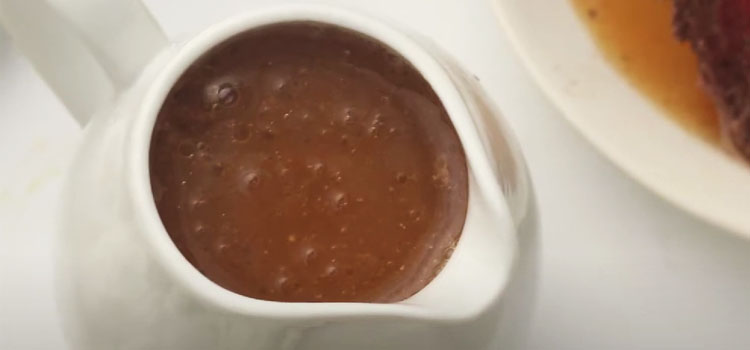Last Updated on September 16, 2024 by Shari Mason
Curious about how long gravy stays good in the fridge? **Gravy**, like other foods, has a specific **shelf life**.
It is essential to know how long gravy is good for in the fridge and when to throw it away. Let me dive in and discover the right time frame to keep that yummy gravy good and ready to eat!
How Long Can Gravy Stay In The Fridge?


Properly stored in a covered container, gravy [1] can remain good for 3 to 4 days. Beyond this period, the taste and safety can be compromised. Always use a clean utensil when serving to prevent contamination.
Gravy, a delicious sauce often poured over meats, potatoes, or rice, can highlight a meal. But, like all foods, it has a limited shelf life.
“I remember that alongside the expected dishes, our family had a few of our own specials too like ‘meen manga curry,’ which had a yummy green-colored gravy.”
– Babu Antony, Indian-American Actor
Proper storage ensures that you can enjoy your gravy safely on another day. Remember, the key is to be mindful of its age and condition. Safety first!
Read:
- How To Make Gravy With Gravy Master?
- Why Put Hard-Boiled Eggs In Gravy?
- How To Make Ham Gravy With Cornstarch?
- How To Make Gravy From Crock Pot Juices?
Can It Stay At Room Temperature?
No, gravy should not be left at room temperature for extended periods. Once prepared or after being served, gravy should be cooled and placed in the refrigerator within 2 hours.
If left out beyond this time, there’s an increased risk of bacteria growth, which can cause foodborne illnesses. Always prioritize safety and refrigerate leftover gravy promptly.
Is It Possible To Freeze Gravy For Later Use?
Yes. Freezing gravy is a handy way to preserve it for future meals.
If you’ve made a large batch or have leftovers, pour the cooled gravy into airtight containers or heavy-duty freezer bags, leaving some space at the top for expansion.
Once sealed, you can store the gravy in the freezer for 4-6 months. When ready to use it, thaw it in the refrigerator overnight and reheat gently on the stove.
This way, you can enjoy the richness and flavor of your gravy even weeks after the initial preparation.
Find out if gravy is better made using flour or cornstarch here.
Signs That It Has Gone Bad


- Unpleasant Smell: If the gravy has an off or sour smell, it’s a clear sign that it’s spoiled. Fresh gravy should have a pleasant and familiar aroma.
- Mold or Discoloration: Visible mold, usually green, white, or black spots, indicates that the gravy is no longer safe to eat. Any change in color, such as a darker shade or a change in consistency, may also indicate spoilage.
- Change in Texture: Gravy that has thickened too much or has separated layers might be past its prime.
- Sour or Off Taste: If you’re unsure about the smell or appearance, a tiny taste (without swallowing) can confirm if it’s off. If it tastes strange, discard it.
- Presence of Bubbles or Fermentation: If you notice bubbles, especially if accompanied by a fermented [2] or sour smell, bacteria are actively breaking down the gravy, and it’s time to throw it away.
“In the dance of flavors, gravy waits patiently in the fridge; but even the best steps have their limit.”
– Eat Pallet Restaurant & Food Advice
Tips On How To Store Gravy
- Cool Before Storing: Before placing gravy in the fridge, let it cool to near room temperature. This prevents condensation inside the container, which can accelerate spoilage.
- Airtight Containers: Store gravy in airtight containers or resealable plastic bags. This keeps out air and contaminants, preserving the gravy’s freshness for longer.
- Keep Away from Contaminants: Make sure the spoon or ladle you use for the gravy is clean. Introducing contaminants can reduce the gravy’s shelf life.
- Label with Date: To keep track, label the container with the date you made the gravy. This way, you’ll always know how old it is.
- Store in Smaller Portions: Consider storing the gravy in smaller portions if you have a large quantity. This way, you can use what you need without repeatedly exposing the entire batch to the air.
- Freeze for Long-Term Storage: If you won’t use the gravy within a few days, freezing is a great option. Pour gravy into freezer-safe bags or containers, leaving some space for expansion.
- Refrigerate Promptly: Don’t leave gravy sitting out for long. Ideally, refrigerate it within two hours of cooking to ensure it remains safe to eat.
- Keep at the Right Temperature: Ensure your refrigerator is below 40°F (4°C). At this temperature, bacterial growth is significantly slowed.
- Reheat Properly: When using stored gravy, reheat it to a rolling boil to kill potential pathogens. Only reheat what you’ll use to avoid multiple reheat-cool cycles.
- Check Regularly: Even with all these precautions, always check for signs of spoilage before consuming. If in doubt, throw it out.
FAQs
u003cstrongu003eHow to thaw frozen gravy? u003c/strongu003e
Transfer the frozen gravy to the refrigerator and let it thaw overnight. Before using, reheat on low heat in a saucepan.
u003cstrongu003eHow many times can I reheat gravy?u003c/strongu003e
It would be best to reheat gravy only once after its initial preparation. Repeated reheating can affect the quality and increase the risk of bacterial growth. Always ensure it’s heated thoroughly before serving.u003cbru003eu003cbru003eFind out u003ca href=u0022https://eatpallet.com/what-gravy-goes-with-ham-and-mashed-potatoes/u0022u003ewhat gravy pairs well with ham and mashed potatoes hereu003c/au003e.
In Conclusion
When storing gravy in the fridge, it’s best to use it within 3 to 4 days. Proper storage, like keeping it in an airtight container, can help maintain its freshness.
While keeping leftovers for extended periods is tempting, it’s essential to prioritize safety and taste. If you need clarification on the gravy’s freshness, always trust your senses and look for signs of spoilage.
If in doubt, it’s better to be safe and dispose of it. Remember, quality and safety go hand-in-hand when enjoying leftovers.
References:
- https://www.delish.com/cooking/recipe-ideas/a50208/perfect-gravy-recipe/
- https://www.britannica.com/science/fermentation
- Can You Put an AC Unit in the Kitchen? - September 27, 2024
- What Cheese Does Olive Garden Use? Discover Their Signature - September 27, 2024
- How to Cancel a Pizza Hut Order? Quick & Easy Guide - September 24, 2024


